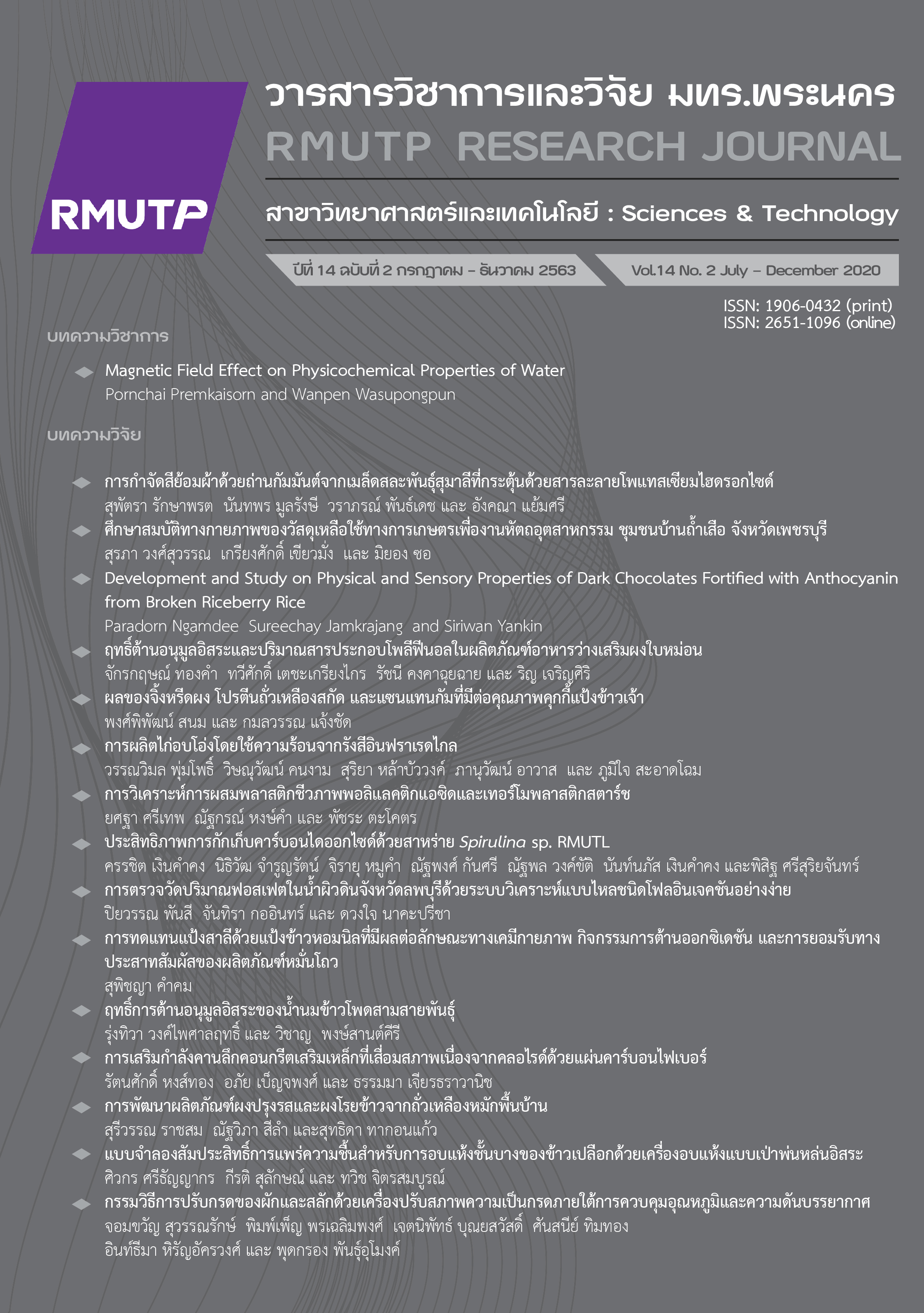Antioxidant Activity of 3 Varieties of Corn Milk
Main Article Content
Abstract
The purpose of this research was to analyze carotenoid content, anthocyanin content, phenolic compound content and the antioxidant activity by 2, 2-diphenyl-1-picrylhydrazyl scavenging capacity (DPPH) and 1, 10-Phenantroline (Phen). In the 3 varieties of corn milk which were the Queen Ruby Siam strain (Purple corn milk), (White corn milk), Sweet strain (Yellow corn milk). It was found that the samples of 3 types of corn milk have total carotenoid content were 0.45+0.00 0.29+0.02 and 0.68+0.00mg/l respectively. Anthocyanin content measured by pH-differential method were 2.86+0.01 1.71+0.03 and 0.80+0.01 mg/l respectively. The total amount of phenolic compounds were 12.00+0.02 10.05+0.00 and 8.62+0.09 mg/l respectively. The ability to resist free radicals by DPPH method were equal to 96.50+0.10 47.10+0.01 and 60.91+0.08 respectively. The antioxidant activity using Phen method were 133.98+0.76 111.17+0.48 and 86.61+0.98 mg/l respectively.
Article Details
References
Thanyalaksaporn Tieoyong. (2019, April 13). Sweet corn and sweet corn planting. [Online]. Available: https://www.nfc.or.th/
content/6944
K. Vayuparp, Specialty Corn Research and development, Research project report, Department of Agriculture, 2015.
P. Pitakpakorn, “Corn milk consumption behavior of consumers in Bangkok Metropolitan area,” Master of Business Administration in Marketing, Srinakharinwirot University, 2003.
B. Harakotr, B. Suriharn, R. Tangwongchai and K. Lertrat. “Profile of phenolic compounds and antioxidant capacity in waxy corn at different maturation stages,” KHON KAEN AGR. J., vol. 43, SUPPL. 1, pp. 311-316, 2015.
B. Harakotr, B. Suriharn, R. Tangwongchai, M. P. Scott and K. Lertrat, “Anthocyanin, phenolics and antioxidant activity changes in purple waxy corn as affected by traditional cooking,” Food Chemistry, vol. 164, pp. 510-517, 2014.
Q. P. Hu and J. G. Xu, “Profiles of carotenoids, anthocyanins, phenolics, and antioxidant activity of selected color waxy corn grains during maturation,” J. Agri. Food Chem, vol. 59, pp. 2026-2033, 2011.
R. Zhang, L. Huang, Y. Deng, J. Chi, Y. Zhang, Z. Wei and M. Zhang, “Phenolic content and antioxidant activity of eight representative sweet corn varieties grown in South China,” International Journal of Food Properties, vol. 20, no. 12, pp. 3043-3055, 2017.
T. Paseephol, R. Prathum and S. Suriyakhan, “Phytochemical constituents and total phenolic content of bicolor corn silk (Zea mays hair) extracts,” HON KAEN AGR. J., vol. 46, SUPPL. 1, pp. 1315-1320, 2018.
Y. Yao, W. Sang, M. Zhou and G. Ren, “Antioxidant and α-glucosidase inhibitory activity of colored grains in China,” J. Agri. Food Chem. vol. 58, pp. 770-774, 2010


